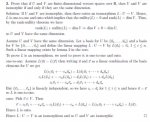I don't really understand what is isomorphism and how to use it. I thought isomorphism as a linear mapping that is one-to-one and on-to.
I have tried to prove the following:
"Let L: U->V and M: V->W be linear mappings. Prove that if L and M are 1:1, then M(L(x)) or M ? L is 1:1"
I proved that C1U1+...+CnUn = 0 has only the trival solution (lamar of 1:1) therefore L(C1U1+...+CnUn) = C1LU1+... +CnLU1=C1V1+...CnVn = 0 has only the trival solustion since L and M are 1:1. Therefore M ? L is 1:1 as well.
I don't know if this make sense or not and if it's too short of a proof.
I have also come across another question:
"Prove that if U and V are finite-dimensional vectors spaces over R, then U and V are isomorphic if and only if (iff) they are the same dimension."
I know that since an Isomorphic mapping has to be 1:1 and onto, which mean that it's bijection so every image has exactly one pre-image or in another word every equation have exactly one solution. Also a theorem states that a linear mapping L: U->V has an iverse linear mapping L^(-1): V->U iff L is 1:1 and onto. Therefore a if U and V are finite dimensional vector spaces then they are isomorphic iff they have the same dimension.
But I don't think this is a good proof, it's more like an explaination. I don't know how to write a proper proof for this.
Helen
I have tried to prove the following:
"Let L: U->V and M: V->W be linear mappings. Prove that if L and M are 1:1, then M(L(x)) or M ? L is 1:1"
I proved that C1U1+...+CnUn = 0 has only the trival solution (lamar of 1:1) therefore L(C1U1+...+CnUn) = C1LU1+... +CnLU1=C1V1+...CnVn = 0 has only the trival solustion since L and M are 1:1. Therefore M ? L is 1:1 as well.
I don't know if this make sense or not and if it's too short of a proof.
I have also come across another question:
"Prove that if U and V are finite-dimensional vectors spaces over R, then U and V are isomorphic if and only if (iff) they are the same dimension."
I know that since an Isomorphic mapping has to be 1:1 and onto, which mean that it's bijection so every image has exactly one pre-image or in another word every equation have exactly one solution. Also a theorem states that a linear mapping L: U->V has an iverse linear mapping L^(-1): V->U iff L is 1:1 and onto. Therefore a if U and V are finite dimensional vector spaces then they are isomorphic iff they have the same dimension.
But I don't think this is a good proof, it's more like an explaination. I don't know how to write a proper proof for this.
Helen


